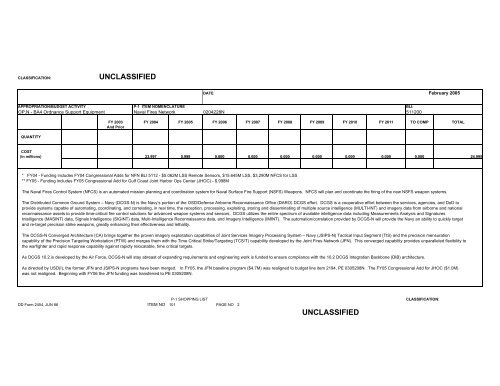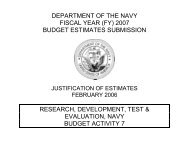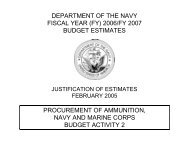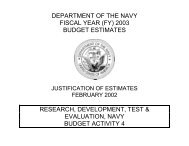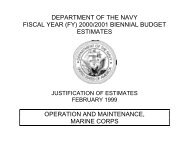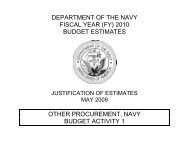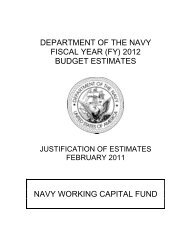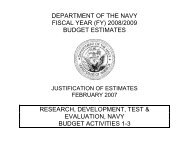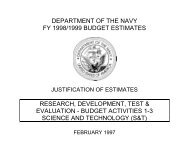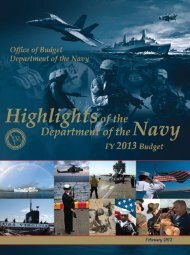Other Procurement, BA 4 - U.S. Navy
Other Procurement, BA 4 - U.S. Navy
Other Procurement, BA 4 - U.S. Navy
Create successful ePaper yourself
Turn your PDF publications into a flip-book with our unique Google optimized e-Paper software.
CLASSIFICATION:UNCLASSIFIEDDATE February 2005APPROPRIATION/BUDGET ACTIVITY P-1 ITEM NOMENCLATURE BLI:OP,N - <strong>BA</strong>4 Ordnance Support Equipment Naval Fires Network 0204228N 511200QUANTITYFY 2003 FY 2004 FY 2005 FY 2006 FY 2007 FY 2008 FY 2009 FY 2010 FY 2011 TO COMP TOTALAnd PriorCOST(in millions) 23.997 0.998 0.000 0.000 0.000 0.000 0.000 0.000 0.000 24.995* FY04 - Funding includes FY04 Congressional Adds for NFN BLI 5112 - $5.062M LSS Remote Sensors, $15.645M LSS, $3.290M NFCS for LSS** *Funding FY05 - Funding includes includes FY04 Congressional FY05 Congressional Adds for Add NFN for BLI Gulf 5112 Coast - $5.062M Joint Harbor LSS Remote Ops Center Sensors, (JHOC) $15.645M - $.998MLSS, $3.290M NFCS for LSS**ASN(RDA) Ltr of 23 Jan 04 realigned Joint Fires Network to DRPM Joint Service Imagery Processing System-<strong>Navy</strong>.The Naval Fires Control System (NFCS) is an automated mission planning and coordination system for Naval Surface Fire Support (NSFS) Weapons. NFCS will plan and coordinate the firing of the new NSFS weapon systems.The Joint Fires Network (JFN) is a system which will automate, coordinate, and correlate, in real time, the processing of multiple tactical data streams from various surveillance/intelligence sources toThe provide Distributed time-critical Common fire control Ground solutions System for – <strong>Navy</strong> advanced (DCGS-N) weapon is the systems <strong>Navy</strong>’s and portion sensors. of the The OSD/Defense automation/correlation Airborne Reconnaissance provided by JFN Office will provide (DARO) the DCGS <strong>Navy</strong> effort. an ability DCGS to quickly is a cooperative target and effort re-target between the services, agencies, and DoD toprovide precision systems weapons, capable greatly of enhancing automating, their coordinating, effectiveness and and correlating, lethality. in real time, the reception, processing, exploiting, storing and disseminating of multiple source intelligence (MULTI-INT) and imagery data from airborne and nationalreconnaissance assets to provide time-critical fire control solutions for advanced weapon systems and sensors. DCGS utilizes the entire spectrum of available intelligence data including Measurements Analysis and SignaturesIntelligence The Littoral (MASINT) Surveillance data, System Signals (LSS) Intelligence is an all source (SIGINT) intelligence, data, Multi-Intelligence surveillance, Reconnaissance reconnaissance, and data, targeting and Imagery system Intelligence that will receive, (IMINT). process The automation/correlation and disseminate information provided in by support DCGS-N of senior will provide military the <strong>Navy</strong> an ability to quickly targetcommanders. re-target precision The system strike can weapons, also be greatly used in enhancing peacetime their to support effectiveness the decision and lethality. making process of civilian authorities in response to Homeland Security requirements and natural disasters such asfloods, earthquakes and hurricanes where timely information on conditions in a given geographical area are required.The DCGS-N Converged Architecture (CA) brings together the proven imagery exploitation capabilities of Joint Services Imagery Processing System – <strong>Navy</strong> (JSIPS-N) Tactical Input Segment (TIS) and the precision mensurationcapability of the Precision Targeting Workstation (PTW) and merges them with the Time Critical Strike/Targeting (TCS/T) capability developed by the Joint Fires Network (JFN). This converged capability provides unparalleled flexibility tothe warfighter and rapid response capability against rapidly relocatable, time critical targets.As DCGS 10.2 is developed by the Air Force, DCGS-N will stay abreast of expanding requirements and engineering work is funded to ensure compliance with the 10.2 DCGS Integration Backbone (DIB) architecture.As directed by USD(I), the former JFN and JSIPS-N programs have been merged. In FY05, the JFN baseline program ($4.7M) was realigned to budget line item 2194, PE 0305208N. The FY05 Congressional Add for JHOC ($1.0M)was not realigned. Beginning with FY06 the JFN funding was transferred to PE 0305208N.P-1 SHOPPING LIST CLASSIFICATION:DD Form 2454, JUN 86 ITEM NO 101 PAGE NO 2UNCLASSIFIED


